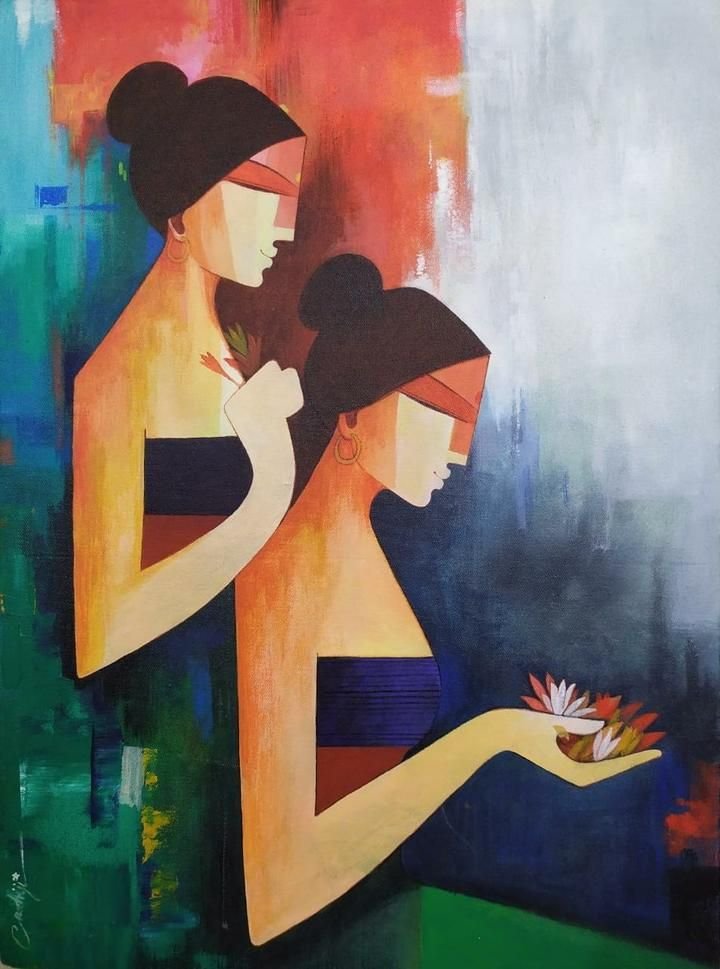Explore the rich tapestry of Indian painting through vibrant colors, intricate details, and diverse themes. From traditional masterpieces to contemporary expressions, delve into the captivating world of Indian artistry. Uncover the essence of India’s cultural heritage and artistic brilliance in every stroke, all within the canvas of our curated collection of Indian paintings.
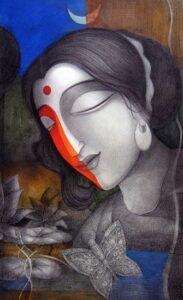
In the dynamic and ever-evolving art landscape, the digital age has ushered in transformative opportunities for artists to showcase their work on a global scale. The rise of online trading in the art world, particularly through web galleries, has become a prominent trend.
This shift not only benefits artists by providing exposure to diverse audiences but also empowers art enthusiasts to explore and acquire Indian Painting from the comfort of their homes. This comprehensive guide aims to assist art buyers in making informed decisions when navigating the online realm for purchasing Indian painting.
The Significance of Online Art Galleries:
Online galleries act as a revolutionary force, democratizing the art world and providing artists, regardless of their geographical location, with a platform to showcase their creations to a global audience.

For instance, an artist working in a village in Madhya Pradesh can now connect with buyers in countries like the USA, breaking down traditional barriers. The ease of access and global reach offered by online galleries has been instrumental in transforming the way art is traded and appreciated.
Why Indian painting Holds International Appeal:
Indian art’s allure lies in its rich tapestry of diverse themes and captivating depictions. Renowned for its vibrant expressions and cultural depth, Indian art paintings has garnered immense popularity in the international art market.
The convenience of online galleries further fuels this global interest, allowing art buyers worldwide to explore and acquire pieces that resonate with the intricacies of Indian culture and artistic expression.
Purchasing from Onsite Galleries vs. Online Galleries:
The debate between purchasing from onsite galleries and online galleries presents a nuanced choice for art enthusiasts. Onsite galleries offer the tactile experience of physically examining artwork, allowing buyers to assess size, texture, and other details firsthand.
Conversely, online galleries provide the convenience of virtual exploration, offering a vast array of artworks without the constraints of physical presence. However, the challenge lies in the inability to physically inspect the artwork, prompting the need for careful consideration before making a purchase.
Reputable online galleries address this concern by providing detailed information, high-quality images, and, in some cases, virtual viewing options to assist buyers in making informed decisions.
Unveiling the Secrets of Buying Indian Painting
- Authenticity Matters:
The prevalence of counterfeit Indian art paintings poses a significant challenge, underscoring the pivotal importance of authenticity in the art-buying process. In this era of online trading, where digital platforms connect artists with a global audience, discerning buyers are confronted with the responsibility of navigating through a sea of potential imitations.
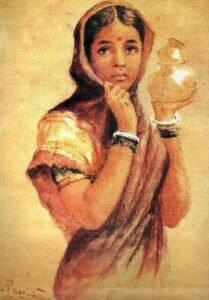
The integrity of the artwork becomes a paramount consideration, urging art enthusiasts to exercise diligence in their selection.
It is strongly recommended that buyers prioritize galleries with an established reputation for consistently offering authentic pieces. By doing so, they not only safeguard their investments but also contribute to sustaining the artist’s livelihood and the true essence of the artwork.
This emphasis on authenticity not only enhances the buyer’s confidence in the legitimacy of their purchase but also reinforces the integrity of the broader art market, fostering an environment where genuine artistic expression flourishes and artists receive the recognition and support they rightfully deserve.
2. Navigate the Size Dilemma:
Navigating the online art market presents a unique challenge when it comes to accurately gauging the size of a painting based solely on digital images. The two-dimensional nature of online representations often fails to convey the physicality and scale of the artwork, making it imperative for prospective buyers to adopt a proactive approach.
To mitigate this challenge, it is recommended that buyers actively engage with gallery authorities by reaching out for precise dimensions.
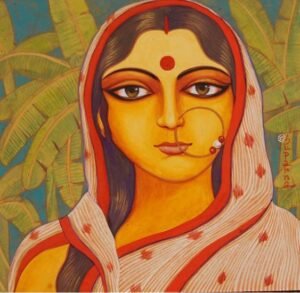
By doing so, they not only gain a deeper understanding of the actual size but also enhance their confidence in the accuracy of the dimensions. This personalized interaction allows buyers to make more informed decisions regarding the suitability of the artwork for their desired space.
The proactive communication between buyers and gallery authorities not only bridges the gap created by the digital medium but also ensures a seamless and satisfactory art-buying experience, where the physical presence and impact of the artwork align harmoniously with the
3. Distinguish Originals from Copies:
In the dynamic landscape of the online art market, the discerning art buyer is confronted with the nuanced challenge of distinguishing between original artworks and reproductions like first copies or digital prints, particularly in the realm of Indian art painting.
As the digital space facilitates the proliferation of both authentic pieces and imitations, prospective buyers are strongly advised to exercise due diligence before making a purchase.
To circumvent potential disappointment, it becomes imperative for buyers to seek clarification from the gallery or seller regarding the authenticity of the artwork. Confirming whether the displayed piece is the original creation or an acknowledged first copy is not merely a formality but a crucial step for those who value the authenticity and uniqueness of the artist’s vision.

This distinction is pivotal, especially for enthusiasts seeking genuine, one-of-a-kind artworks that encapsulate the artist’s creative spirit.
By taking this proactive approach, buyers can ensure that their acquisition aligns with their expectations and fulfills the desire for an art piece that not only resonates aesthetically but also bears the unmistakable imprint of the artist’s individuality.
This emphasis on authenticity fosters a more transparent and trustworthy online art market, where the integrity of artistic expression remains paramount, and buyers can confidently invest in pieces that truly reflect the artist’s unique vision.
4. Consider Customized Options:
In the expansive realm of online art galleries, a noteworthy trend emerges, offering art enthusiasts the alluring prospect of customized paintings. For buyers seeking a deeply personal and tailored touch to their art collection, these options are a beacon of creative individuality.
To embark on this artistic journey, it is essential for buyers to engage in thoughtful inquiries regarding the artist responsible for the customization process.
Understanding the artist’s style, background, and approach to personalized creations ensures a seamless collaboration and allows buyers to make an informed decision. Furthermore, delving into the specifics, such as adherence to specified dimensions, preferred themes, and other personalized preferences, becomes crucial.
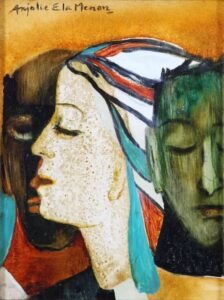
This meticulous exploration ensures that the resulting artwork aligns harmoniously with the buyer’s artistic vision and complements the intended space.
The process of acquiring a customized piece becomes a collaborative venture, where the buyer’s desires converge with the artist’s skill, resulting in a unique masterpiece that transcends conventional boundaries.
This emphasis on personalized art not only adds a distinctive touch to the buyer’s collection but also fosters a deeper connection between the artist and the enthusiast, creating a symbiotic relationship that celebrates individual expression within the vast canvas of the online art world.
5. Shipping and Delivery Protocols:
While the convenience of free home delivery services offered by most web galleries is undoubtedly enticing, a discerning art buyer recognizes the importance of delving into the intricacies of the shipping and delivery process. It is advisable for buyers to go beyond the surface and inquire about the detailed procedures involved in the transit of their precious artwork.
Seeking clarity on delivery timelines, packaging methods, and the overall logistics not only enhances the buyer’s understanding but also adds an extra layer of assurance regarding the safety and security of the purchase.
Additionally, savvy buyers should ascertain whether the gallery provides shipment tracking services, enabling them to monitor the artwork’s journey in real-time and ensuring a heightened sense of confidence in the delivery process. However, the responsibility doesn’t end with the click of the ‘order’ button.
A vigilant post-delivery inspection becomes imperative, serving as the final checkpoint to identify any potential damage incurred during transit.
By meticulously examining the artwork upon receipt, buyers can promptly address and report any issues to the gallery, facilitating a swift resolution and safeguarding the integrity of their art acquisition.
This meticulous approach to the shipping and delivery aspects not only elevates the overall buying experience but also exemplifies the buyer’s commitment to ensuring the safe and pristine arrival of their cherished artwork.
6. Verify Authenticity with Certificates:
In the intricate world of indian painting acquisition, the pursuit of authenticity reaches its zenith as buyers are encouraged to fortify their investment by actively seeking copyright details or a certificate of authenticity signed by the artist. This deliberate step transcends the mere act of purchase, becoming a strategic move to safeguard the genuineness of the acquired artwork.
By requesting such documentation, buyers not only establish a concrete link to the legitimacy of the piece but also create a robust foundation for future endeavors, especially in scenarios where the contemplation of resale arises.
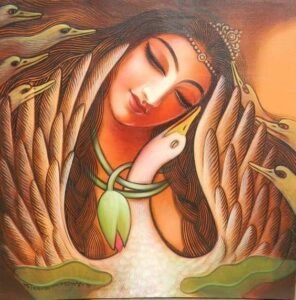
A certificate of authenticity serves as a potent testament to the origin and uniqueness of the artwork, reassuring buyers about the artistic provenance and intrinsic value. This invaluable documentation becomes a cornerstone, eliminating uncertainties about the authenticity of the piece and providing a seamless trajectory for potential resale. Moreover, it serves as a testament to the artist’s acknowledgment of the work, adding a personal touch to the transaction.
In essence, this conscientious approach not only enhances the buyer’s confidence in their investment but also contributes to the preservation of the artist’s legacy, creating a symbiotic relationship between the creator and the collector within the intricate tapestry of the art world.
7. Transparent Cost Assessment:
Buyers navigating the enticing realm of online Indian painting galleries must remain vigilant, understanding that the prices prominently displayed on websites might not comprehensively cover taxes or additional fees. As they progress through the checkout process, a meticulous examination of the total bill becomes imperative, serving as a crucial step in gaining a transparent understanding of the overall cost.
This conscientious scrutiny is essential to uncover any hidden taxes or fees that may contribute to the final expenditure. Embracing this transparency is not merely a matter of financial prudence but a strategic approach to sidestep unexpected financial surprises that could potentially impact the budget.
By delving into the intricacies of the total cost, including taxes, buyers can navigate the purchasing journey with clarity and confidence, ensuring a seamless and gratifying experience.
This emphasis on transparency in pricing not only fosters a sense of trust between the buyer and the online gallery but also contributes to the overall integrity of the art-buying process, allowing enthusiasts to make informed decisions without encountering unforeseen financial hurdles.
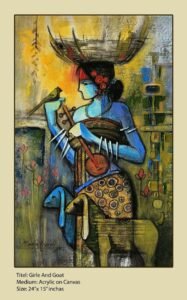
In the dynamic landscape of online art commerce, making informed choices is paramount for both artists and buyers. The fusion of technology and art has brought about a remarkable transformation, democratizing the art world and providing a platform for artists from all corners to share their creativity with the world.
By considering authenticity, size, customization options, and other crucial factors, art enthusiasts can confidently navigate online galleries, ensuring a rewarding and enjoyable experience when acquiring Indian painting.
The online trading of Indian painting has not only opened new avenues for artists who may lack resources for traditional marketing but has also enriched the global art scene, fostering a more interconnected and accessible community of creators and connoisseurs.
As technology continues to shape the art world, the seamless integration of online platforms promises an exciting future for artists and art lovers alike.

